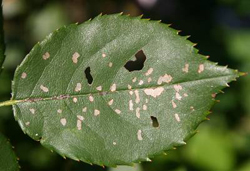by Marty Reich, Master Rosarian, Editor of the Rose Leaf

By looking at the bush before you cut, you can shape its future growth by cutting at a node facing the way you want the bush to grow. I usually cut back the laterals on the big canes of my climbers to 2 or 3 nodes similar to the Feb. pruning.
OK, all that careful examining is not for you, so what option does that leave you? One of the founders of NRS, Glenda Whitaker, said you could just pinch or cut off the dead bloom and let the bush decide for itself where the next growth will come from. This may cause a somewhat unruly looking bush with smaller blooms, but certainly can be done.
Spraying chemical sprays when temperatures are in the 90’s for prolonged periods–what to do?
Some top exhibitors spoke to us once and said that they sprayed anyway, believing that some spray burn was better than letting disease get ahead of them. Of course, you should not spray when the sun is directly on the bushes, so very early or late in the day are best times. There has been no rain since I sprayed last week so I will probably wait for a few days and see if it gets cooler. Honor Guard should be good for 2 weeks, Spinosad has some long lasting properties and Mancozeb is still visible on leaves so I should be alright for a while.
What I have been doing is spraying water on the mulch and the lower leaves of the bushes almost every day to prevent spider mites from getting a start. They are tiny and suck the leaves dry and multiply very quickly. If you see leaves getting crispy, turn them over and you will see tiny black specks like pepper and possibly small webs. Wash both sides of the leaves vigorously with water every day for several days and that should break the life cycle. I know this goes against the “don’t wet the leaves” rule, but this is the exception to that rule. Blackspot does not grow much with high temps, but spider mites love hot and dry weather.


Yellow leaves on a bush can be worrisome, particularly for new rosarians. Causes are many, too much or too little water, disease, pH, lack of nitrogen or more simply, just old age! Sometimes, leaves at the bottom of an established plant will turn yellow and that just means they have aged out. If drainage is poor or if rain has been heavy for quite some time, that can be a cause. Roses need 1 1/2″-2″ per week of rain or 5-10 gal. of water if it does not rain. Do not plant a rose in a hole that has poor drainage! So, if you have lots of yellow leaves and cannot figure out a cause, call a CR for a consult.
That’s it for this month. Happy rose growing, drink lots of water and take it easy in the sun.
